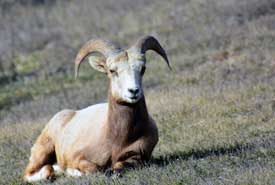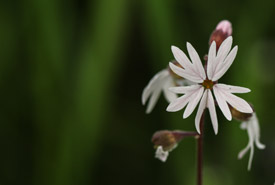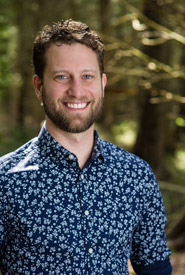Biomimicry: Every step is a story

A bighorn sheep on Luxor Linkage conservation area (Photo by Bonnie-Lou Ferris)
When I first learned about biomimicry, I was in a math and poetry class at Queen’s University in Kingston, Ontario. It was 2004, and while the professor didn’t necessarily talk about the term “biomimicry,” he introduced us to the idea that nature is much more complex, and yet organized, than we realized.
The professor walked us through something called the Fibonacci sequence, which is a pattern of sequential numbers (for example, 0, 1, 1, 2, 3, 5, 8, 13,…) where the next number in the sequence is found by adding up the two numbers before it. Through a little geometry magic, the sequence could be organized into a specific ratio, called the golden ratio, and into a 137.5-degree angle. To me, the interesting thing about these patterns was that they were littered throughout the natural world. For example, the spirals you see in pine cones, the seed packaging of a sunflower, the swirl of a hurricane and horns of a ram, are all natural occurrences of the Fibonacci sequence and golden ratio in nature.
What was fascinating to me was that nature was doing design. I was studying engineering at the time, and to think that nature “used” math, or followed a specific mathematical formula, disrupted my notion that we were the engineers, and nature was random chaos. It opened a whole new lens with which to view the world, one that has held me in a mild obsession ever since.

Small-flowered woodland star in the Cowichan Garry Oak Preserve (Photo by Sarah Boon)
In 2007, I joined Janine Benyus on a two-week workshop in Costa Rica on the concept of biomimicry. Janine is the author of Biomimicry: Innovation inspired by nature and the woman who coined the term biomimicry.
In her book, she defines biomimicry as the conscious emulation of nature’s genius. With a fleet of naturalists, she used this definition to reframe our understanding of nature and to share the stories of nature’s forms, processes and systems. At her workshop, she told me and other attendees about the way peacocks create colour without pigments. She showed us the way nature worked in closed economies, or in sharing economies, where there was no unemployment and where nothing was wasted.
Through her stories, a flower became an example of efficient packaging, a tree in the side of a cliff was an expert in structural engineering, mangroves were desalination plants, leaves were solar harvesters and mycelium were broadband information networks.
Every step in that forest was another story, and every step since has been an opportunity to add to that story. My obsession with biomimicry is fueled by the belief that we can source a higher level of design when we are in nature, and find new assumptions for how the world works. Through biomimicry, we can learn to think, behave and create from a new model; one that is in harmony with nature and, therefore, more efficient, resilient and beautiful.


